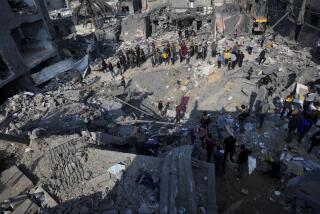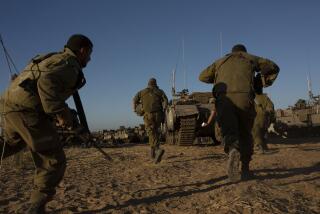SCHWARZKOPF’S STRATEGY
- Share via
The strategy was launched Aug. 7, just five days after Iraq’s invasion of Kuwait. It was relentlessly executed through months of U.N. negotiation, six weeks of allied bombing and five days of lightning-fast ground war against experienced Iraqi forces that greatly outnumbered allied combat troops. While pockets of Iraqi resistance remain, the Iraqi army is effectively out of commission.
Aug. 7, 1990-Jan. 17, 1991: DECEPTION
In early August, a limited defense force was put in place behind a Saudi task force along Saudi Arabia’s border with Kuwait and Iraq. By November, in response to massive numbers of Iraqi troops pouring south to the border, U.S. and Arab forces were built up in defensive positions aligned north against Iraqi positions in Kuwait. At the same time, the U.S. Navy built up a conspicuous presence in the Gulf. When diplomatic efforts failed, a massive air war was begun to weaken the Iraqi forces, particularly along the border.
The Strategy: Make the Iraqis think that their main engagement with the allies would occur along the Kuwait border, forcing them to concentrate troops there. Lead them to expect an amphibious assault, something they greatly feared. Isolate Kuwait, preventing Iraq from resupplying, reinforcing or communicating with troops. Put as many Iraqi units out of commission as possible.
Saturday, Feb. 23, 1991: THE ‘HAIL MARY’
Schwarzkopf and other allied commanders evaluated the number Iraqi divisions still functioning after more than five weeks of bombing and saw much better odds than those that existed in August. The destruction of their air force left the Iraqis blind to what the allies were doing. Schwarzkopf launched what he called his “Hail Mary” play--moving a massive number of troops and tons of materiel far to the west at blitzkrieg speed, knowing that the dug-in Iraqis were essentially immobilized along the Kuwaiti border.
The Strategy: The allies along the Kuwait border faced units at only 50% to 75% of their original strength. And they were then in position to flank the Iraqis on the west, while the Iraqis still expected the assault at the Kuwaiti border.
Sunday morning: THE FEINT
Against a background of amphibious maneuvers and naval gunfire, the 1st and 2nd Marine divisions and Saudi forces launched attacks and breached the barriers in the south. The Iraqis apparently believed tha they had guessed right, and they were totally unaware of what was going on to the west: a deep thrust by French armored and U.S. airborne divisions to take an Iraqi airfield at Al Salman. At the same time, the U.S 101st Airborne established a forward base deep inside Iraq.
The Strategy: To rivet the Iraqis’ attention on the assault in Kuwait while establishing a left flank deep in Iraqi territory. That would allow allied troops to move through areas with little to no opposition to positions behind the dug-in Iraqis.
Sunday afternoon: MOVING ON THREE FRONTS
1. The U.S. 1st and 3rd Armored divisions and 2nd Armored Cavalry Division thrust north, encountering minimal Iraqi resistance. The 101st Airborne drove farther into Iraq. At this point, allied troops were within just 150 miles of Baghdad.
2. The U.S. VII Corps breached the barriers and pushed into Iraq, followed by the British 1st Armored Division.
3. In what Schwarzkopf called a “superb operation,” the Marines pushed ahead toward Kuwait city, encountering heavy artillery fire, mines, barbed wire, booby traps and fire-filled trenches. They met with thousands of surrendering Iraqis. Arab forces penetrated the border defenses in southern and southwestern Kuwait.
The Strategy: The deception continued to work: The Iraqis believed the allies were mounting an all-out assault in the east while U.S., French and British forces quickly went around enemy fortifications and blocked the Iraqis on the west. For the Marines, strategy gave way to the hard work of capturing Kuwait city.
Monday and Tuesday: TIGHTENING THE NOOSE
1. The 24th Infantry Division punched all the way through to the Tigris and Euphrates Valley, blocking any escape route along the rivers by the Republican Guard.
2. The 101st Airborne also helped seal off northern positions, while the French set up a defensive flank to the west.
3. British forces and the VII Corps turned east to fight Iraqi forces from behind.
4. Arab troops turned east to meet up with the forces closing in on Kuwait city.
5. The Saudis and Marines pressed on north toward Kuwait city.
6. Special Forces teams cleared mines in the Gulf and performed other small-boat maneuvers that might precede an amphibious landing.
The Strategy: To finally trap the Iraqis on all sides.
Wednesday and Today: ‘CLOSING THE GATES’
The 18th Airborne Corps has created a solid wall across the north, with the VII Corps just to the south. Both are attacking the Republican Guard directly to the east. Arab and Kuwaiti forces are securing Kuwait city, and the 1st Marine Division holds the airport there. The 2nd Marines are blocking escape routes out of the city. In Schwarzkopf’s words, “the gates are closed.”
More to Read
Sign up for Essential California
The most important California stories and recommendations in your inbox every morning.
You may occasionally receive promotional content from the Los Angeles Times.










